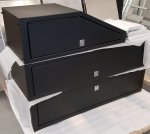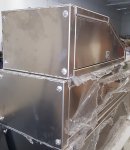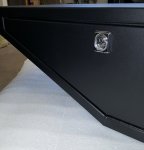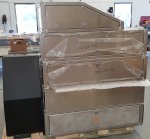We put the finished camper on our scale. It weighs 4,950 pounds. We know there is about 300 pounds we can remove. The weight is low and rides well on truck. The motorcycle lift is mounted to truck frame and easily lifts two wr250 bikes with spare tire.
You are using an out of date browser. It may not display this or other websites correctly.
You should upgrade or use an alternative browser.
You should upgrade or use an alternative browser.
Xpedition Camper out of Minnesota
- Thread starter Hoefler
- Start date
southpier
Expedition Leader
... Note: the rear overhang is designed to reduce the low pressure zone at the rear wall off camper when speeding down the highway.
Pete
http://forum.expeditionportal.com/attachment.php?attachmentid=379954&stc=1&thumb=1&d=1482852869
could you please elaborate on this?
We plan on starting one.The new website looks great, have you thought about starting an Instagram account?
Thanks for the nice compliment as well.
Pete
In my early days, I raced bicycles. An in this, I learned how to draft semi trucks and city dock trucks. When one gets close-very close to the back of a large vehicle, there is no air movement and even a little bit of a vacuum. Squared of vehicle bodies actually creates a vacuum in the back. On road trips I began to notice fold out trailer tails on truck trailers and got to thinking about a campers tall profile and how it would act the same way.
So, I did an experiment and found that on a square backed camper that I build delivered on average 8 miles per gallon at an average 1000 foot above seal level in my RAM 5500. Given that the front pressure zone on a large profile vehicle is roughly equal to the rear vacuum zone, we went about changing the front and rear profile to improve fuel consumption on our camper.
First, we increased the slope of the top of our cab over along with pinched the sidewalls in. Given a queen mattress is 60" wide, we didnt find the need to have the front of our cab over width equal to the body width. Additionally, we added a top sort of duck tail to the rear roof section to assist in smoothing air flow over and around camper.
With these changes, we set of for Flagstaff and chose a rout through South Dakota, then south through the rockies and through Moab. We found our fuel mileage increased to 10.5 average MPG at nominal 1,000 FASL. Travel speed was 75 MPH. Once through the rockies and the higher elevations, our mileage went to 12.8 to almost 13.5 MPG. The logical explanation for the higher MPG at higher elevations would be air density. The higher up one goes, the lower the density of air.
Upon heading back home through Oklahoma then straight up Interstate 35, we found our mileage dropped back down to 10.5. We have since taken camper of truck and have operated the vehicle less camper and are getting 12.5 MPG.
Non of our testing was scientific, however it did provide enough information to shed daylight between, blunted front and rear profile to a somewhat sculpted one. We plan on doing a little more work to the rear to further enhance air flow at rear.
The discoveries we found:
Our first squared of body camper-poor fuel efficiency, poor side wind control-much jostling.
Our second camper with 16" popped out rear with sloped bottom and rather blunt faced cab over-better fuel efficiency and much smoother in cross winds.
The Flagstaff camper-with pinched cab over and duck tail-better fuel mileage and still super smooth in heavy cross winds.
In conclusion, our basic trial and error method has yielded positive results.
Pete
So, I did an experiment and found that on a square backed camper that I build delivered on average 8 miles per gallon at an average 1000 foot above seal level in my RAM 5500. Given that the front pressure zone on a large profile vehicle is roughly equal to the rear vacuum zone, we went about changing the front and rear profile to improve fuel consumption on our camper.
First, we increased the slope of the top of our cab over along with pinched the sidewalls in. Given a queen mattress is 60" wide, we didnt find the need to have the front of our cab over width equal to the body width. Additionally, we added a top sort of duck tail to the rear roof section to assist in smoothing air flow over and around camper.
With these changes, we set of for Flagstaff and chose a rout through South Dakota, then south through the rockies and through Moab. We found our fuel mileage increased to 10.5 average MPG at nominal 1,000 FASL. Travel speed was 75 MPH. Once through the rockies and the higher elevations, our mileage went to 12.8 to almost 13.5 MPG. The logical explanation for the higher MPG at higher elevations would be air density. The higher up one goes, the lower the density of air.
Upon heading back home through Oklahoma then straight up Interstate 35, we found our mileage dropped back down to 10.5. We have since taken camper of truck and have operated the vehicle less camper and are getting 12.5 MPG.
Non of our testing was scientific, however it did provide enough information to shed daylight between, blunted front and rear profile to a somewhat sculpted one. We plan on doing a little more work to the rear to further enhance air flow at rear.
The discoveries we found:
Our first squared of body camper-poor fuel efficiency, poor side wind control-much jostling.
Our second camper with 16" popped out rear with sloped bottom and rather blunt faced cab over-better fuel efficiency and much smoother in cross winds.
The Flagstaff camper-with pinched cab over and duck tail-better fuel mileage and still super smooth in heavy cross winds.
In conclusion, our basic trial and error method has yielded positive results.
Pete
shortbus4x4
Expedition Leader
Wow. Just read the whole thread. You do nice work.
southpier
Expedition Leader
....I did an experiment and found that on a square backed camper that I build ...
whew; guess you really looked at this modification close. thank you for the explanation (I just got back to this thread)
shortbus4x4
Expedition Leader
Congratulations.
Tool boxes
We have been very busy. We have our new tray pak in the works are nearly finished with our first unit. We have developed a set of tool boxes that bolt on to any truck body. Boxes are made of aluminum, TIG welded and have a nice seal area. Each box has a bolt on shield for taking on debris released from rear tires.
We are offering these for sale with any custom sizing. With the door figured out, and the flat pattern worked, we are able to reproduce these in custom sizes.
Options include powder coating, birch plywood liners, stainless steel construction, different lengths and shapes. Standard size is 18" wide x 13" tall x 53" long for the straight box and 39" long for the rear slope box. We also provide a stainless steel blank that bolts onto rear box for field fitting of fuel hose. Ram 5500 box comes pre cut for filler hose.
Standard boxes run $1,300 each.
Pete
We have been very busy. We have our new tray pak in the works are nearly finished with our first unit. We have developed a set of tool boxes that bolt on to any truck body. Boxes are made of aluminum, TIG welded and have a nice seal area. Each box has a bolt on shield for taking on debris released from rear tires.
We are offering these for sale with any custom sizing. With the door figured out, and the flat pattern worked, we are able to reproduce these in custom sizes.
Options include powder coating, birch plywood liners, stainless steel construction, different lengths and shapes. Standard size is 18" wide x 13" tall x 53" long for the straight box and 39" long for the rear slope box. We also provide a stainless steel blank that bolts onto rear box for field fitting of fuel hose. Ram 5500 box comes pre cut for filler hose.
Standard boxes run $1,300 each.
Pete
Attachments
Similar threads
- Replies
- 7
- Views
- 2K
- Replies
- 1
- Views
- 720
- Replies
- 21
- Views
- 12K
- Replies
- 0
- Views
- 1K





